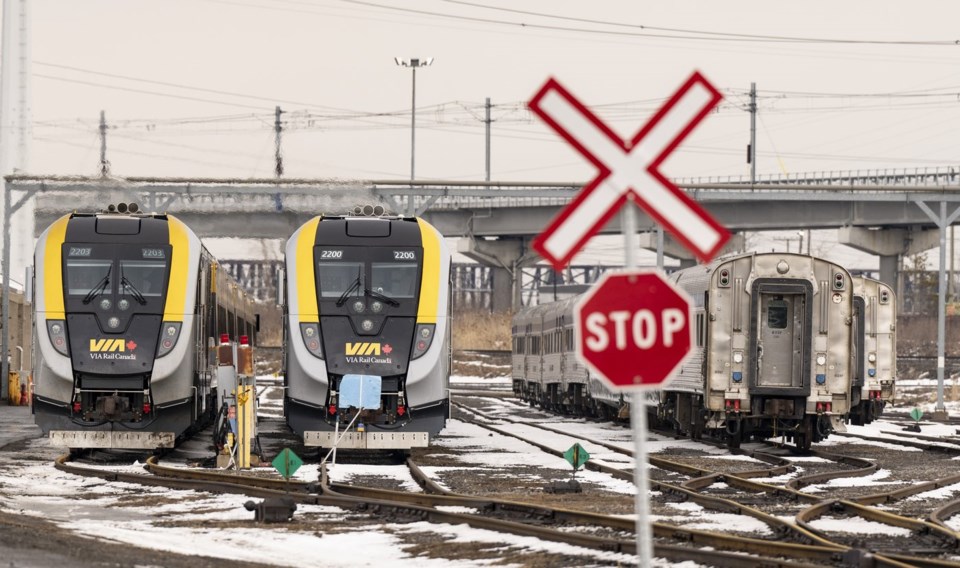MONTREAL — Bold plans and promises for high-speed rail lines in Canada stretch as far back as Pierre Trudeau's government. So far, none have come to pass.
Some two dozen studies, market assessments, special reports and task force papers have been carried out since 1984, according to the High Speed Rail Canada platform, an online resource on the subject.
Now, the Liberal government's announcement of a high-speed project set to connect Toronto and Quebec City — complete with $3.9 billion in fresh funding and selection of a consortium to design, build and run the route — go further than any previous attempt.
Here's a look at some of the key dates in previous attempts for faster rail travel:
1971
A Canadian Transport Commission study in 1970 takes a hard look at high-speed rail between Montreal, Ottawa and Toronto. But it finds that "TurboTrains" offer the best way to improve passenger service, "maximizing the potential" of existing tracks rather than upgrading rail infrastructure at high cost.
Introduced a couple of years earlier, the gas turbine-powered Turbos were technically capable of 270 km/h speeds. They never broke 160 km/h on Canadian rail lines, however, meaning they fell short of what's typically considered the high-speed threshold. The lower speed owed to tight turns, at-grade road crossings — where slowdowns are required — and the fact that the speedy coaches ran on the same tracks as lumbering freight trains, which had priority — and still do.
Via abandoned the Turbo in 1982 and replaced it with conventional, diesel-electric powered Bombardier trains that topped out at about 160 km/h.
1981
After pledging to create a nationwide carrier akin to Amtrak in the U.S. during the 1974 election campaign, then-prime minister Pierre Trudeau asks Via Rail to figure out if there is a future for high-speed rail in Canada. In 1984, the Crown corporation notes its "promise" for revenues and ridership, citing networks such as Japan's bullet train to France's Train à Grande Vitesse. (Canada remains the only Group of Seven country without a high-speed network.)
"There is little doubt that consideration of high-speed rail will be a key part of longer-range national plans for modernizing Canada‘s passenger railway system," states the 1984 report. Longer-range indeed. Seven months later, the two-decade Liberal reign in Ottawa ends and more detailed plans fail to materialize under Brian Mulroney's Progressive Conservatives.
1995
"There have been many studies of the potential application of high-speed rail to the Québec-Windsor Corridor," reads an 89-page report from Transport Canada — from 1995. It concludes that a 300 km/h line is pricey but feasible, with Montreal-Ottawa-Toronto as the "best scenario." It predicts revenues would hit $1.5 billion in 1993 dollars, or about $2.8 billion today, accounting for inflation.
Despite an endorsement from both prime minister Jean Chretien and Quebec premier Lucien Bouchard — bitter adversaries on Quebec sovereignty — the report goes on to gather dust on a shelf.
2002
Yet another Via report revives high-speed hopes. It lays out a federal project dubbed ViaFast to cut travel times — by half in some cases — along the Windsor-Quebec City corridor: to two hours and 15 minutes between Toronto and Ottawa; to one hour and 15 minutes from Ottawa to Montreal. But Paul Martin's successor Liberal government scraps the undertaking.
2017
In Ontario, then-premier Kathleen Wynne announces plans for a high-speed line between Toronto and London, Ont., by 2025. The provincial Liberals commit $11 billion to the effort in their 2018 budget, less than three months before Doug Ford's Conservatives sweep to power. The following year, his government's first budget freezes capital funding and halts plans for the tracks.
2024
Discussion of a bullet train between Calgary and Edmonton has bubbled up periodically in Alberta since 2011. That line as well as commuter rails for both cities form part of the government’s goal of a provincewide passenger rail network, with spikes in the ground as early as 2027.
Premier Danielle Smith announces in April the government's intention to hammer out a 15-year master plan by the summer of 2025. No routes have yet been announced.
2025
The federal government said on Feb. 19 it would move forward with the next phase of building a high-speed rail network between Quebec City and Toronto.
The Liberal government said the planned rail network — which is expected to take several years to design and build — will be 100 per cent electric, span approximately 1,000 kilometres, and reach speeds of up to 300 kilometres an hour. The route would include stations in Toronto, Peterborough, Ottawa, Montréal, Laval, Trois-Rivières and Quebec City.
This report by The Canadian Press was first published Feb. 19, 2025.
Christopher Reynolds, The Canadian Press

